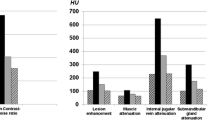The purpose of this study was to evaluate the feasibility and usability of digital image fusion of different phases in spiral CT studies of the head and neck. Patients with squamous cell carcinomas underwent dual-phase spiral CT using a contrast material. The images of the early phase were showing optimal vascular enhancement. The images of the late phase were showing optimal tumor conspicuity. Selected images of the early phase were fused with selected images of the late phase by application of user-centered developed software. The image fusion was done in a semi-automatically way on a desktop computer (PC). The relationship between tumors and adjacent vessels was better visualized on the fused images than on the original source images. As a conclusion it can be emphasized, that digital image fusion of early and late phases enabled combined opacification of vessels and squamous cell carcinomas, which facilitated the topographic assessment of the tumors size and spread.
Generell sind Radiologen sehr gut trainiert, verschiedene Bilder mental zu vergleichen; dennoch ist dieser mentale Vergleich nicht nur anstrengend, sondern auch schwierig. Aus diesem Grund wurde eine spezielle Software zur Bildüberlagerung entwickelt, die mittlerweile im Routinebetrieb eingesetzt wird. Die vorliegende Arbeit befasst sich mit Fragen der Usability bei der Kombination von durch Kontrastmittel verstärkten Gefäßbildern und Tumorbildern zur besseren und gleichzeitigen anatomischen Darstellung von Gefäßen und so genannten "squamous cell-Karzinomen" in der Hals- und Kopfregion. Bei einer zeitlichen Serie von CT-Aufnahmen einer Region wird ein Kontrastmittel injiziert. Bei den ersten Bildern der Serie werden so die Gefäße optimal dargestellt. Bei den letzten Bildern der Serie ist das Kontrastmittel aus den Gefäßen ausgetreten und wurde zum Teil von den Tumoren aufgenommen. Es wird jetzt jeweils ein Bild vom Anfang der Serie und ein Bild vom Ende der Serie durch Bildüberlagerung kombiniert. Ergebnis: Die computerunterstützte Bildüberlagerung liefert eine bessere anatomische Darstellung von Gefäßen und (squamous cell-) Karzinomen in der Hals- und Kopfregion.
Similar content being viewed by others

References
Bauman, R. A., Gell, G. (2000): The reality of picture archiving and communication systems (PACS): a survey. J Digit Imaging. Nov; 13 (4): 157–169.
Brix, G., Beyer, T. (2005): PET/CT: dose-escalated image fusion? Nuklearmedizin.; 44 [Suppl 1]: 51–57.
Choi, D. S., Na, D. G., Byun, H. S., et al. (2000): Salivary gland tumors: evaluation with two-phase helical CT. Radiology 214: 231–236.
Groell, R., Doerfler, O., Schaffler, G. J., Habermann, W. (2001): Contrast-enhanced helical CT of the head and neck: increased conspicuity of squamous cell carcinoma on delayed scans. AJR 176: 1571–1575.
Halpern, B. S., Schiepers, C., Weber, W. A., Crawford, T. L., Fueger, B. J., Phelps, M. E., Czernin, J. (2005): Presurgical staging of non-small cell lung cancer: positron emission tomography, integrated positron emission tomography/CT, and software image fusion. Chest. Oct; 128(4): 2289–2297.
Harris, E. W., La Marca, A. J., Kondroski, E. M., Murtagh, F. R., Clark, R. A. (1996): Enhanced CT of the neck: improved visualization of lesions with delayed imaging. AJR 167: 1057–1058.
Higashino, H., Mochizuki, T., Haraikawa, T., Kurata, A., Kido, T., Nakata, S., Sugawara, Y., Miyagawa, M., Miki, H., Koyama, Y., Okayama, H., Higaki, J. (2006): Image fusion of coronary tree and regional cardiac function image using multislice computed tomography. Circ J. Jan; 70 (1): 105–109.
Holzinger, A. (2005): Usability engineering for software developers. Communications of the ACM, Vol. 48, Iss. 1: 71–74.
Holzinger, A., Geierhofer, R., Ackerl, S., Searle, G. (2005): CARDIAC at VIEW: The user centered development of a new medical image viewer. In: Zara, J., Sloup J. (eds.) Proc. of Central European Multimedia and Virtual Reality Conference CEMVRC 2005: 63–68.
Kagawa, K., Lee, W. R., Schultheiss, T. E., et al. (1997): Initial clinical assessment of CT-MRI image fusion software in localization of the prostate for 3D conformal radiation therapy. Int J Radiat Oncol Biol Phys 38: 319–325.
Nicoletti, R., Wiltgen, M., Kronberger, L., et al. (1993): Superimposition of MR-Images and Scintigrams as an Application of PACS. In: Lemke, H. U., Inamura, K., Jaffe, C. C., Felix, R. (eds). Computer Assisted Radiology, Proc. of the Int. symposium CAR 93. Berlin, Heidelberg, New York: Springer-Verlag: 77–82.
Vogel, W. V., Wiering, B., Corstens, F. H., Ruers, T. J., Oyen, W. J. (2005): Colorectal cancer: the role of PET/CT in recurrence. Cancer Imaging. Nov 23; 5 Suppl S: 143–149.
Wahl, R. L., Quint, L. E., Greenough, R. L., et al. (1994): Staging of mediastinal non-small cell lung cancer with FDG PET, CT and fusion images: preliminary prospective evaluation. Radiology 191: 371–377.
Wiltgen, M., Gell, G., Graif, E., Stubler, S., Kainz, A., Pitzler, R. (1993): An integrated PACS-RIS in a radiological department. J Digit Imaging. 6(1): 16–24.
Wiltgen, M. (1999): Digitale Bildverarbeitung in der Medizin. Grundlagen der Verarbeitung bildhafter Informationen für die Interpretation und Kommunikation in der Medizin. Aachen: Shaker-Verlag.
Author information
Authors and Affiliations
Rights and permissions
About this article
Cite this article
Wiltgen, M., Holzinger, A., Groell, R. et al. Usability of image fusion: optimal opacification of vessels and squamous cell carcinoma in CT scans. Elektrotech. Inftech. 123, 144–147 (2006). https://doi.org/10.1007/s00502-006-0330
Issue Date:
DOI: https://doi.org/10.1007/s00502-006-0330



